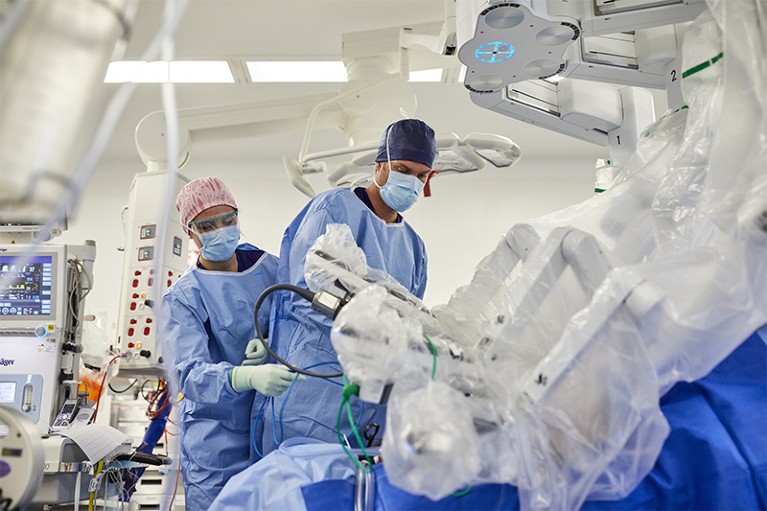
Urology fellow, Jeremy Fallot, and nurse, Shauna Harnedy, assist in robotic surgery by Ruban Thanigasalam (out of view) in Sydney, Australia.Credit: Ken Leanfore for Nature
Loved by surgeons and patients alike for its ease of use and faster recovery times, the da Vinci surgical robot is less invasive than conventional procedures, and lacks the awkwardness of laparoscopic (keyhole) surgery. But the robot’s US$2-million price tag and negligible effect on cancer outcomes is sparking concern that it’s crowding out more affordable treatments.
There are more than 5,500 da Vinci robots globally, manufactured by California-based tech giant, Intuitive. The system is used in a range of surgical procedures, but its biggest impact has been in urology, where it has a market monopoly on robot-assisted radical prostatectomies (RARP), the removal of the prostate and surrounding tissues to treat localized cancer. Uptake in the United States, Europe, Australia, China and Japan for performing this procedure has been rapid. In 2003, less than 1% of surgeons in the US performed a RARP in preference to open or laparoscopic surgery. By 2014, RARP accounted for up to 90% of radical prostatectomies across the country. When it comes to prostate cancer surgery in the United States, says Benjamin Davies, surgeon and professor of urology at the University of Pittsburgh, “the die is cast; there is only robotic surgery”.
After lung cancer, prostate cancer is the second most common cancer in men worldwide. It affects the walnut-sized prostate gland, which sits up against the urethra, between the rectum and bladder, and secretes prostate fluid, a component of semen. The prostate’s proximity to the blood vessels, muscles and a fragile web of nerve bundles that control erectile and bladder function, demands extreme surgical precision in its removal, a procedure that is generally recommended if the disease has not yet spread. Whereas an open patient needs to be cut from naval to pubic bone in order to access the prostate, a robot-assisted procedure requires a few small abdominal incisions.
Known as a master–slave system, the da Vinci comprises three main components. The tower (or ‘slave’) wields three arms equipped with instruments such as forceps, hooks and needle-drivers, and a fourth holds cameras capable of 15 times magnification. The console (‘master’) is where the surgeon sits, a few metres from the patient, remotely operating the robot arms while watching through a 3D stereoscopic monitor. A separate cart contains image-processing equipment.
Surgeons prefer to use the da Vinci robot because it offers improved visualization and hand and wrist flexibility, and they can be seated throughout the 2- to 4-hour procedure. “We can see the anatomy of the prostate like we have never seen it before,” says Freddie Hamdy, Nuffield professor of surgery and urology at the University of Oxford, UK, which is ranked 26th in the Nature Index for cancer research output.
Cancer outcomes equal
Whether these improvements translate to better long-term outcomes for the patient, however, remains unclear. Ruban Thanigasalam, associate professor of robotic surgery at the University of Sydney and clinical lead in prostate cancer research at the Institute of Academic Surgery in Australia, is conducting a trial comparing open and robotic surgery. The preliminary results support what has been widely accepted by surgeons for years: robotic-surgery patients experience reduced blood loss, less pain and shorter recovery time, but the longer-term outcomes are equivalent.
“Anecdotally, we find that recovery of continence is earlier in the robotic group, but after 12 months, there is no major difference between the two for urinary control and sexual function,” says Thanigasalam. For the cancer itself, he adds, the outcomes are the same.
“Several international studies looking at tens of thousands of patients have all shown that there is absolutely no difference in cancer outcomes between robotic and open surgery.”
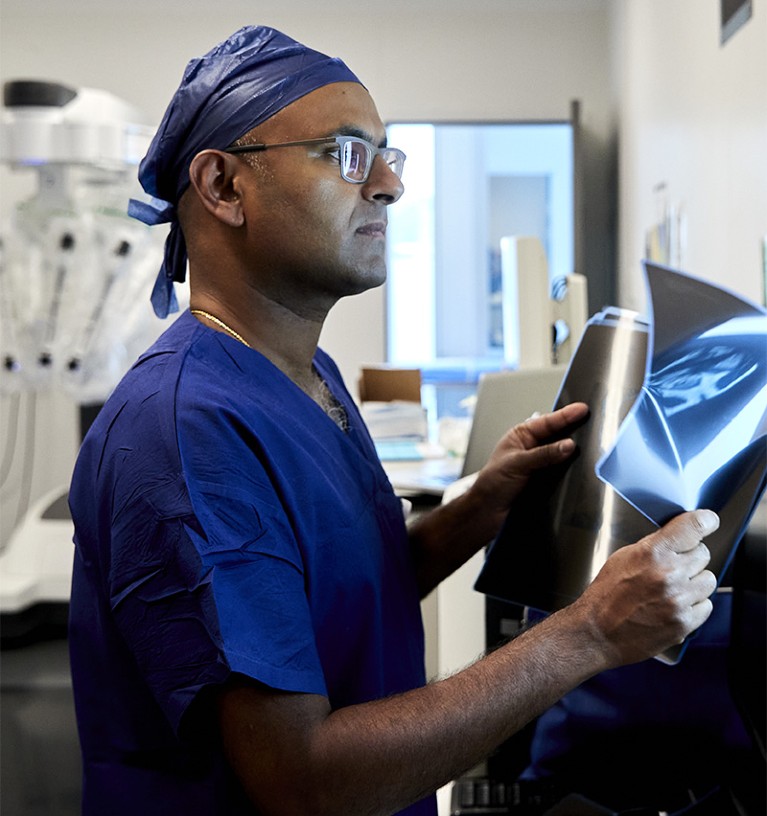
Success of robotic surgery lies solely in the skill of a surgeon, says Ruban Thanigasalam. Credit: Ken Leanfore for Nature
Thanigasalam stresses that the outcomes of robotic surgery remain dependent on the surgeon’s skills, a sentiment echoed by Davies: “It’s always the surgeon’s hands, not the technology we use.”
Even da Vinci’s proponents acknowledge the temptation to overplay its ability. “We all love a good robot,” says Richard Sullivan, professor of cancer and global health at King’s College London and director of the Institute of Cancer Policy in the United Kingdom. “Human beings, particularly surgeons, are incredibly neophilic. We love this sort of thing, it gives us authority. And the patient will think that, because you’ve got all of this fancy kit, you must have better outcomes. But that’s not true, the robot is not an indicator of quality.”
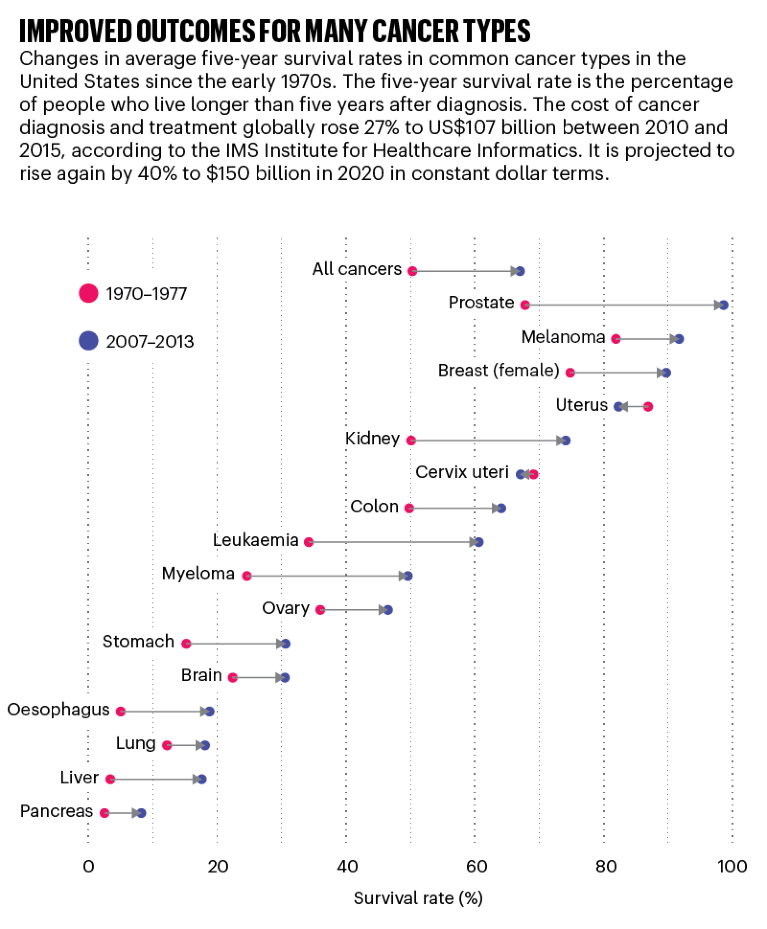
Source: International Health Metrics and Evaluation, Global Burden of Disease from Roser, M. & Ritchie, H. ‘Cancer’ https://ourworldindata.org (2020)
Accessibility gap
According to a 2017 report by the Royal Australasian College of Surgeons and Australian health insurance provider, Medibank, the cost of a prostate cancer procedure varied nationwide from Aus$14,553 to Aus$55,928 (US$9,165 to US$35,222). The use of robotics, the report states, “can substantially increase the cost”.
Despite questions over value for money, business is booming. In 2018, the global surgical robots market was worth US$6.8 billion, and it’s predicted to hit $17 billion by 2025. In response to the surge in robotic surgery, the US Food and Drug Administration (FDA) urged patients and health-care providers to exercise caution last year, particularly with regards to breast and cervical cancer, citing a lack of long-term evidence. “The problem is, once it becomes adopted, it can be very difficult to pedal it back,” says Hamdy.
A “massive inequality gap” is opening between hospitals that can afford the robot, and those that can’t, says Sullivan. “In many countries, we’re fighting for patients because of choice and competition. If I’ve got a robot, I can sell that fact to patients, and they’ll come to me rather than the centre down the road.”
A 2019 paper co-authored by Sullivan for the World Health Organization found that competition between hospitals with and without surgical robots contributed to the closure of 25% of radical prostatectomy centres in the English National Health Service. This focus on “expensive medicines for wealthy patients in wealthy countries”, the paper states, is putting low-income groups at a disadvantage by crowding out spending on the development of preventative measures (R. Sullivan and A. Aggarwal in Reducing Social Inequalities in Cancer: Evidence and Priorities for Research, IARC Monograph, 2019).
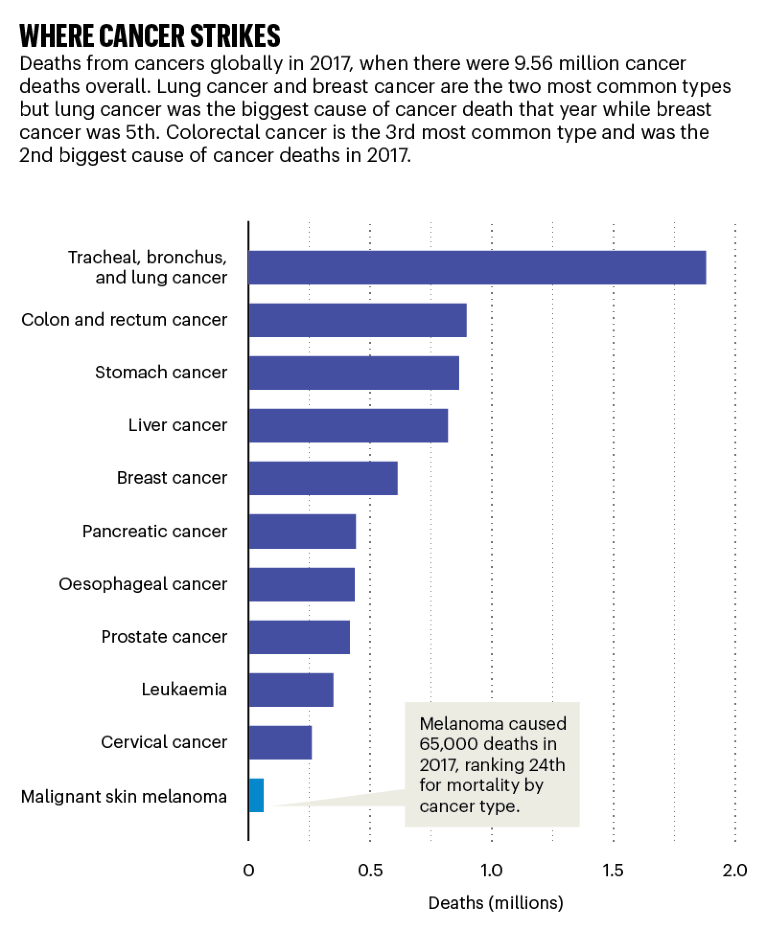
Source: International Health Metrics and Evaluation, Global Burden of Disease from Roser, M. & Ritchie, H. ‘Cancer’ https://ourworldindata.org (2020)
A stark divide also exists between high-income and low- and middle-income countries, which makes it difficult to treat patients across borders, says Sullivan. “Most of our juniors [in the UK] have been trained in minimally invasive and robotics surgery,” he says. “They’re saying, ‘If I want to work somewhere like Zambia or India, I’m screwed if I’ve only done minimally invasive or robotics.’ Outside the high-income settings, these services aren’t available.”
Competition could drive the price of the da Vinci robot down, such as from UK-based CMR Surgical, which has raised $240 million since 2016 for its Versius robot, and Verb Surgical, a partnership between Johnson & Johnson and Alphabet.
Improved screening could see fewer men undergoing surgery in the first place. There is evidence that the benefits of the prostate-specific antigen (PSA) blood test, which, along with a digital rectal examination, is the most common way to screen for prostate cancer, may not outweigh the potential harm of misdiagnosis leading to unnecessary surgery or radiation. Researchers from the Queen Mary University of London and University of East Anglia, UK, are developing blood and urine tests to be used in conjunction with the PSA.

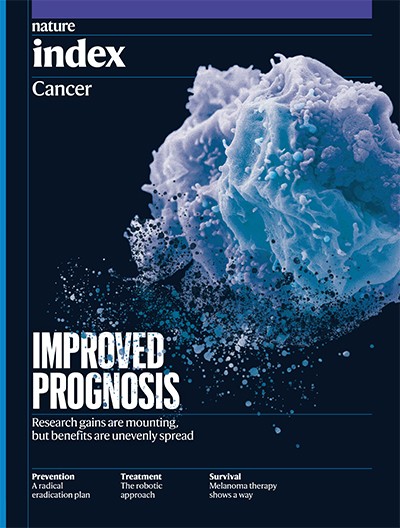
 A global drive to eliminate cervical cancer
A global drive to eliminate cervical cancer
 Game-changing class of immunotherapy drugs lengthens melanoma survival rates
Game-changing class of immunotherapy drugs lengthens melanoma survival rates
 Three researchers who are coming at cancer from all angles
Three researchers who are coming at cancer from all angles







